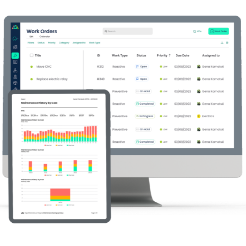
How Contractors Add Value to the Maintenance Operations
Handing a slice of your maintenance workload to a contractor is less about “giving up control” and more about ensuring equipment uptime, keeping assets running smoothly, preventing safety incidents, and continually improving processes. Every hour a critical asset sits idle, it bleeds revenue and erodes safety margins. Meanwhile, maintenance backlogs swell as seasoned technicians retire faster than replacements can be onboarded.
Industry research shows that 88% of facilities now outsource at least part of their maintenance. On average, 23% of the total workload is outsourced, primarily due to skill gaps among in-house staff and a lack of time or labor resources to keep pace.
In this environment, outsourcing has emerged as a strategic operational solution. Plants can flex capacity on demand, shift risk, and convert lumpy capital outlays into predictable operating expenses by engaging contractors with specialized certifications, cutting-edge diagnostic tools, and round-the-clock crews. It frees up in-house technicians’ time to focus on continuous improvement rather than firefighting.
This article offers a data-driven roadmap for how contractors add value to maintenance operations: you’ll learn when to engage external partners, how to select and contract the right vendor, and which KPIs demonstrate their impact long after the ink is dry.

What is Maintenance Outsourcing?
Maintenance outsourcing involves hiring an external company or a maintenance contractor to handle equipment and facility upkeep, as well as repairs. These contractors’ core focus is maintenance, and they bring specialized skills, tools, and a workforce on a flexible basis, stepping in for routine tasks, peak workloads, or emergency fixes.
Comparative Analysis: In‑House vs. Outsourced Maintenance
Deciding between in-house maintenance and outsourcing comes down to weighing control, cost structure, expertise, and flexibility.
In-house teams promise deep knowledge of assets, instant response times, and complete data ownership; however, they incur fixed labor costs, ongoing training needs, and capital expenditures for tools and equipment. Here’s a quick comparison :
|
In-House Maintenance |
Outsourced Maintenance |
|
Fixed salaries, benefits, and training overhead. |
Variable service fees are billed on a per-engagement basis. |
|
Direct oversight with deep site and asset knowledge. |
SLA-governed performance and mobilization timelines. |
|
Own capital investment in tooling and software. |
Contractor supplies specialized diagnostic equipment. |
|
Complete control of processes, data, and Intellectual Property. |
Requires clear data access and ownership agreements. |
|
Immediate response from dedicated staff. |
Elastic workforce scaled to peak or specialized needs. |
|
Self-managed compliance and safety protocols. |
Compliance risk is shared under contract terms. |
Outsourced maintenance converts those fixed expenses into predictable operating fees, providing on-demand access to certified specialists, advanced diagnostics, and surge capacity governed by Service Level Agreements (SLAs). This approach shares compliance and performance risk with vendors but requires resources for managing contracts, including data rights and response commitments.
Many organizations strike a balance with a hybrid model, retaining core internal technicians for mission-critical systems while leveraging outsourced experts for routine inspections, emergency repairs, and other specialized tasks. This enables optimization of reliability, control of costs, and agility in dynamic operating environments.
Core Values Contractors Add to Maintenance Operations

1. Specialized Skills & Certifications
Maintenance contractors supply niche expertise, such as Non-Destructive Testing (NDT) inspectors, PLC programmers, and confined-space specialists, without wasting time on hiring.
2. Refocus on Core Business
By offloading routine and specialized tasks, internal technicians devote more time to process optimization, driving throughput gains and innovation rather than firefighting.
3. Access to Advanced Tools & Diagnostic Tech
Outsourced teams arrive equipped with costly IoT sensors, drone inspection rigs, and CMMS-integrated Predictive maintenance (PdM) systems.
4. Economies of Scale & Predictable Budgeting
Contractors spread fixed costs for tools, training, and support by sharing resources among multiple clients. You benefit from a fixed-fee agreement that turns variable maintenance spikes into a stable, forecastable expense.
5. Speed-to-Value & Reduced Downtime
Established protocols enable rapid crew mobilization and efficient repairs, restoring production faster than building the same capability in-house.
6. Labor Scalability & Seasonality Flexibility
Contractors adjust their workforce to match your needs during shutdowns or peak maintenance periods, so organizations avoid permanent headcount costs and idle labor.
7. Compliance & Safety Accountability
Vendors handle OSHA training, maintain safety documentation, and coordinate audits under contract, reducing your risk of fines and work stoppages.
8. Cost Predictability via SLAs
Service-level agreements tie fees to performance metrics such as response time and first-time fix rates, enabling precise budgeting based on agreed service standards.
9. Data-Driven Continuous Improvement
Contractor dashboards provide real-time KPIs, such as MTBF and trends in unplanned downtime, which fuel root-cause analysis programs that enhance asset reliability.
When Does Outsourcing Make Sense?
Outsourcing maintenance delivers maximum value under specific conditions. Facilities managing an aging asset base with limited in-house expertise can rely on specialized contractors to extend equipment life. Companies operating multiregional sites benefit from a centralized vendor network that enforces consistent standards across geographies. When Capital Expenditure (CapEx) budgets are constrained, outsourcing shifts unpredictable capital projects into predictable Operational Expenses (OpEx) commitments.
Also, in a complex regulatory environment, safety mandates and environmental rules become easier to navigate with contractor-managed compliance. Finally, digital transformation initiatives, such as IoT sensors and predictive analytics, become easier when contractors bring the necessary tools, integrations, and field data experience without straining internal teams.
Procurement & Implementation Best Practices
Selecting the Right Contractor
Start with a qualification checklist before engaging. Verify industry certifications (ISO 9001, ISO 55001), OSHA safety record, and proven CMMS integration. Evaluate predictive-maintenance expertise, data-sharing policies, and references demonstrating responsiveness and root-cause analysis. Prioritize vendors with multi-industry references and acceptable liability insurance to mitigate legal and financial risk.
Start with Critical Assets
Start small by selecting one high-impact asset group, such as pumps or HVAC units, for the first contractor engagement. This focused approach limits risk, generates early performance data, and builds confidence before scaling up.
CMMS Integration for Transparent Reporting
Ensure the contractor logs all work orders, parts usage, and inspection results directly into your existing CMMS. Shared data access enables real-time tracking of Key Performance Indicators (KPIs), such as downtime, mean time to repair, and compliance tasks.
Ensure Smooth Communication
Hold a formal kickoff meeting with your team and contractor leads to agree on objectives, roles, and service-level agreements (SLAs). Then, schedule status calls and shared dashboard updates daily during the pilot phase and weekly afterward to review progress and resolve issues promptly.
Relationship Management
Appoint an internal maintenance champion as your contractor's single point of contact. This person will coordinate projects and scope, enforce Service Level Agreements (SLAs), handle any escalations, and drive continuous improvement on both sides.
Request-for-Proposal (RFP) Essentials
Craft an RFP that clearly defines the scope of work, performance KPI targets (Including MTTR and uptime), escalation and governance protocols, pricing structure, and termination/exit clauses to mitigate risk and ensure accountability. Include clear SLA metrics to align performance expectations and request trial periods to validate service quality before committing to the long term.
Measuring Performance & Success
Operational KPIs
To gauge operational effectiveness, track the Mean Time to Repair (MTTR) and Mean Time Between Failures (MTBF). A declining Mean Time To Resolution (MTTR) indicates faster restoration of assets, while a rising Mean Time Between Failures (MTBF) reflects improved reliability. Compare the ratio of planned versus unplanned work to understand how preventive maintenance efforts are reducing the need for reactive maintenance. Finally, calculate the percentage of planned work orders that actually get done to spot any missed jobs or coordination problems.
Cost & ROI Analysis
By breaking down every cost and benefit line item and applying the ROI formula, you demonstrate exactly how each dollar invested in outsourced maintenance yields measurable returns. A positive percentage confirms that the program is profitable, often paying for itself within the first year. You can calculate ROI using the format below:
|
Category |
Details |
|
Costs |
Direct labor (contractor wages, field technicians); Indirect overhead (management time, facilities support); Training and onboarding fees; Software and license subscriptions; Inventory carrying costs (spare parts, tooling) |
|
Benefits |
Savings from reduced unplanned downtime; Avoided capital expenditure on replacement assets; Fewer emergency repairs and expedited‐shipping fees; Improved first‐time fix rates and extended asset life |
|
ROI Formula |
ROI = (Total Benefits−Total Costs) / Total Costs × 100 |
|
Example |
$100,000 investment, $140,000 in combined savings: ROI = ( $140,000 − $100,000 ) / $100,000 × 100 = 40 % |
Continuous Improvement
Embed a continuous-improvement cycle by holding quarterly business reviews with your contractor to examine KPI trends, diagnose problem areas, and set refined targets. Conduct root-cause analyses on recurring failures to uncover systemic issues and inform corrective actions. Use those insights to revise service-level agreements iteratively, tighten response times, adjust performance metrics, or introduce penalties, ensuring your outsourcing relationship aligns with your operational goals.
Common Mistakes to Avoid When Outsourcing
Outsourcing maintenance can mean losing control over service quality and timing, relying too heavily on a single provider, and facing communication gaps when work orders lack sufficient detail. Contractors may focus on reactive fixes if preventive measures aren’t specified in the contract, and hidden fees or inflexible terms can disrupt budgets. Missing records or weekly schedules hinder planning, while vague data and IP clauses pose legal risks. To prevent these problems, maintain oversight of key processes, require clear performance targets and full fee schedules, include strong data-access and IP terms, vendor stability, and keep backup providers ready.
Conclusion
Outsourcing maintenance turns unpredictable labor and equipment costs into structured investments. By selecting vendors with specialized skills, advanced diagnostic tools, and clear service agreements, you can reduce downtime, scale your workforce as needed, and capture reliable data.
Success depends on solid procurement steps, well-crafted RFPs, seamless CMMS reporting integration, regular communication, and ongoing performance measurement. Avoid common errors by keeping strategic oversight, enforcing data access and IP terms, aligning incentives with preventive goals, and maintaining backup providers. This framework makes maintenance outsourcing a reliable, continuous-improvement engine that supports your core objectives and boosts asset performance.
TABLE OF CONTENTS
Keep Reading
The longest U.S. federal government shutdown to date lasted 43 days, beginning on October 1, ...
5 Dec 2025
Every maintenance professional faces it sooner or later — that critical time when an aging ...
18 Nov 2025
The term 'best' is often used loosely, without a clear understanding of its context or ...
14 Nov 2025
In the not too distant past, maintenance strategies have been defined by reaction—fixing ...
13 Nov 2025
Tax season is the time of year that often sends a ripple of anxiety through many of us. The ...
11 Nov 2025
Selecting a Computerized Maintenance Management System (CMMS) can, at first glance, be an ...
4 Nov 2025
In healthcare facilities, equipment uptime involves more than achieving operational ...
31 Oct 2025
Companies are subject to economic ups and downs, also known as economic volatility. Today, ...
30 Oct 2025
Maintenance challenges are a constant struggle, with unplanned downtime costing manufacturers ...
27 Oct 2025
Last winter, a maintenance technician at a U.S. paper mill ignored a predictive alert that ...
10 Oct 2025
Many organizations proudly say they “have a CMMS,” but ownership alone doesn’t equal ...
9 Oct 2025
Every maintenance team is under pressure to do more with less. Unplanned downtime is often ...
7 Oct 2025
The implementation of simple, yet powerfully effective, checklists has repeatedly ...
3 Oct 2025
In manufacturing, every second counts. When production stops, whether due to scheduled ...
2 Oct 2025
The increasing cost of maintenance, lack of accountability, and siloed systems leave many ...
30 Sep 2025
Preventive maintenance is one of those things maintenance teams know they need to do, but it ...
26 Sep 2025
Public services are essential to daily life. The provision of safe roads, functional transit, ...
25 Sep 2025
For most manufacturing facilities, a major focus of their maintenance teams revolves around ...
24 Sep 2025
Have you ever tried explaining to the CEO why the production line has been down for hours ...
18 Sep 2025
Over the past few decades, the hotel industry has undergone a dramatic transformation. ...
16 Sep 2025





